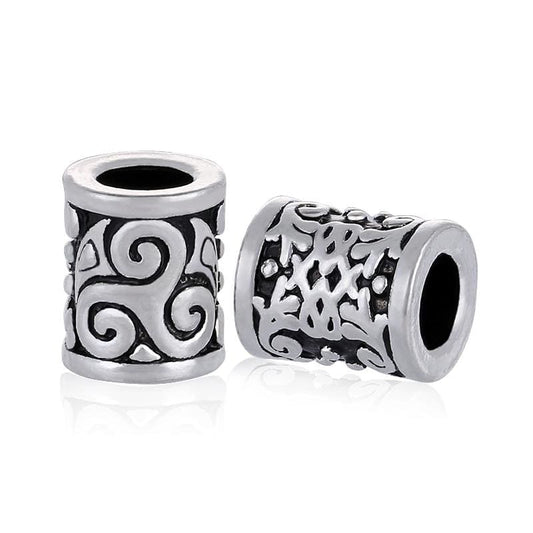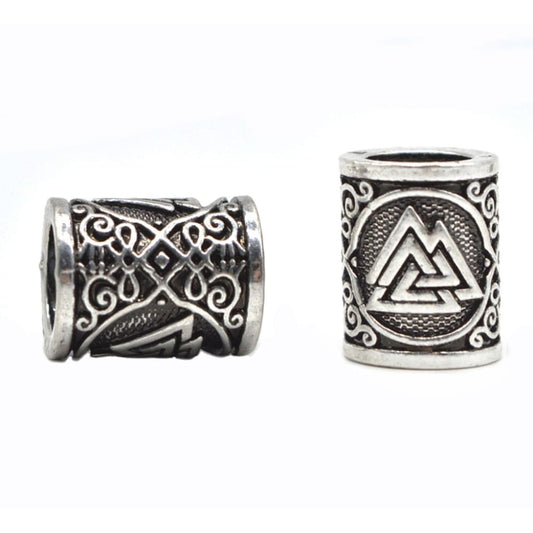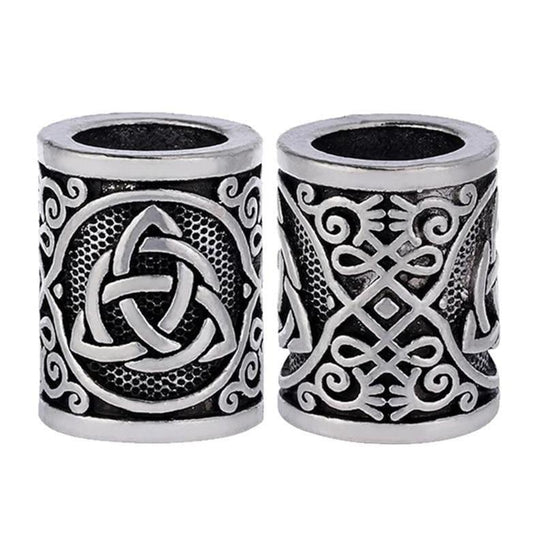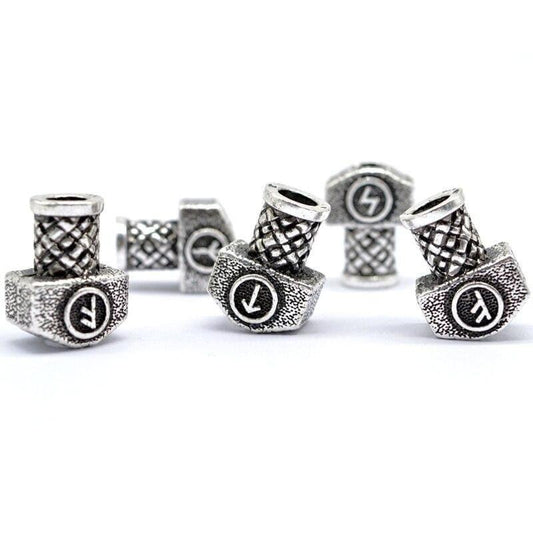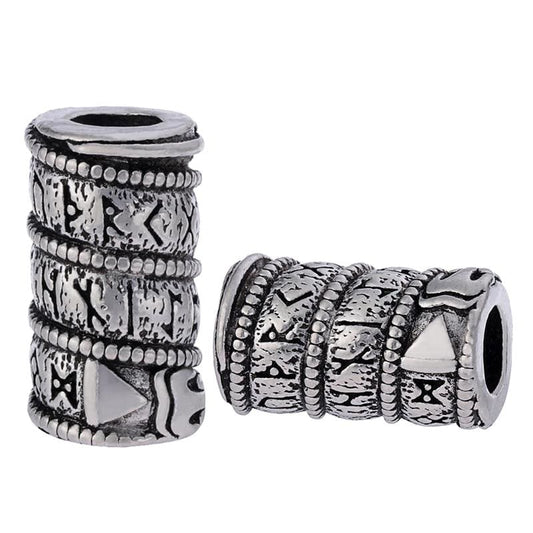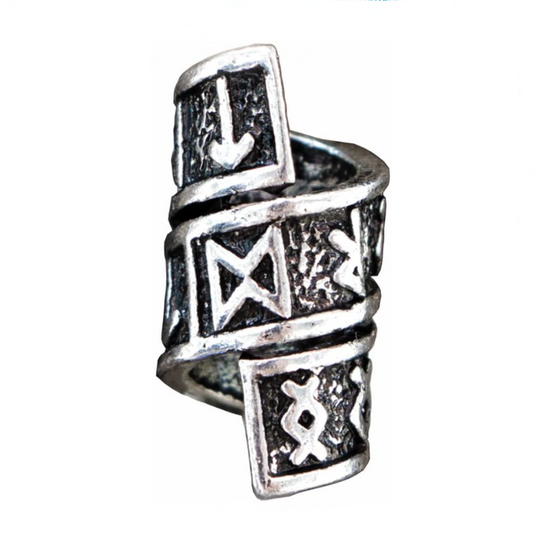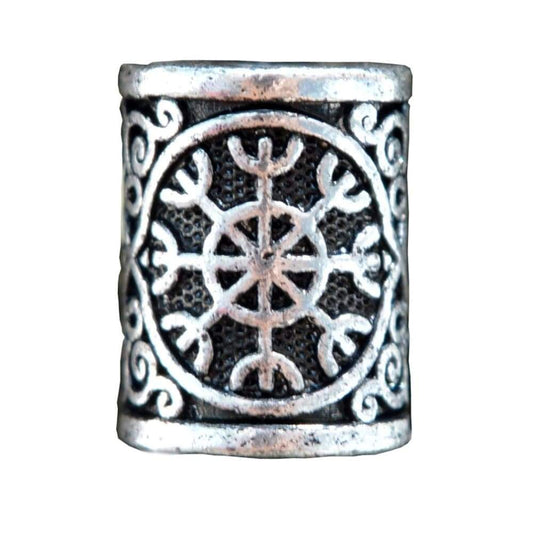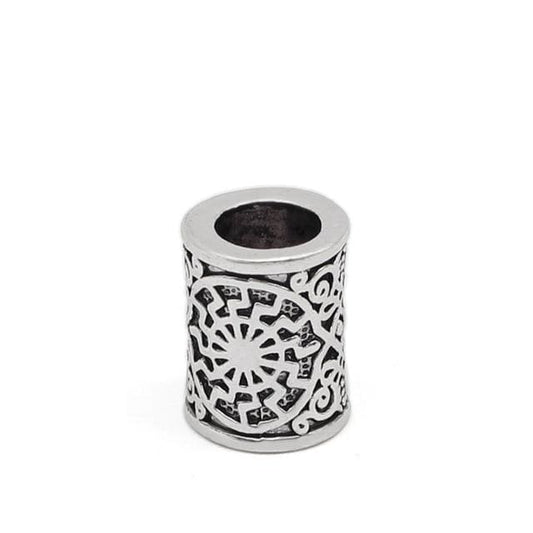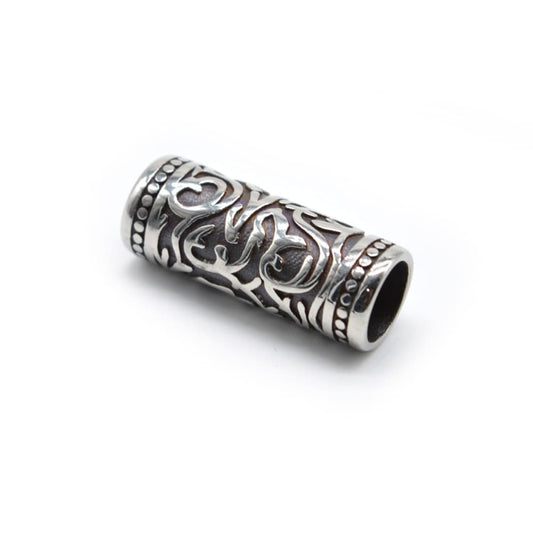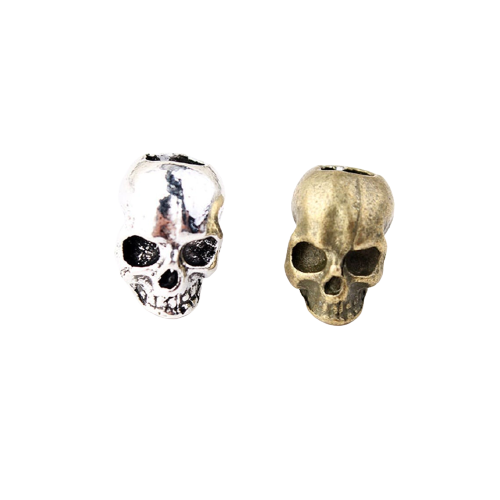Harald, son of Sigurd (known in Norway as Harald Hardrada; Harald Sigurdsson; in Old Norse: Haraldr Sigurðarson)). He received the nickname of Hardråde (harðráði, literally "the Hard" or "the Hard to the great lords and clergy").
He was the king of Norway as Harald III from 1046 until the date of his death in 1066. In addition, he unsuccessfully claimed the Danish throne until 1064 and the English throne in 1066. Before becoming king, he had spent about 15 years in exile as a mercenary - military commander in Kievian Russia and head of the Varangian Guard in the Byzantine Empire.
When he was 15, in 1030, he fought in the battle of Stiklestad along with his half-brother Olavus. Olavus sought to regain the Norwegian throne, which he had lost to the Danish King Cnut the Great two years earlier. In the battle, both brothers were defeated by forces loyal to Cnut, and Harald was sent into exile in Kievian Russia.
He then spent some time in the army of Grand Prince Jaroslav the Wise, eventually obtaining the rank of captain, until he moved to Constantinople with his companions around 1034.
In the Byzantine capital, he soon became the commander of the Varangian guard, and commanded its actions in the Mediterranean Sea, Asia Minor, Sicily, possibly the Holy Land, Bulgaria, and Constantinople itself, where he became involved in dynastic imperial disputes. Harald accumulated considerable wealth during his time in the Byzantine Empire, which he sent to Jaroslav in Kievian Russia for safekeeping.
He finally left the Byzantines in 1042, and arrived in Kiev in order to prepare his campaign to regain the throne of Norway. Possibly to his knowledge, in his absence the Norwegian throne had been restored by the Danes to Olavus' illegitimate son, Magnus the Good.
In 1046, Harald joined forces with Magnus' rival in Denmark (who had also become king of that country), the suitor Svend Estridsson, and began to invade the coast of the territory.
Magnus, unwilling to fight his uncle, agreed to share the reign with Harald, provided that Harald in turn would share his wealth with him. The co-kingdom ended abruptly the following year since Magnus died and Harald thus became the sole ruler of Norway.
Internally, he crushed all local and regional opposition, and outlined the territorial unification of Norway under one national governance. His reign was probably one of relative peace and stability, and he instituted a viable economy with currency and foreign trade.
Probably seeking to restore Cnut's "North Sea Empire," he also claimed the Danish throne, and spent almost every year until 1064 invading the Danish coast and fighting against his former ally, Svend.
Although the campaigns were successful, he was never able to conquer Denmark. Not long after renouncing his claim to Denmark, the former Count of Northumbria, Tostig, brother of the newly chosen King of England Harald II (Harald, son of Goduinus), pledged his loyalty to the King of Norway and invited him to claim the English throne.
Harald traveled along and entered northern England in September 1066, where they stormed the coast and defeated the regional English forces at the Battle of Fulford near York. Although initially successful, he was defeated and killed in an attack by Harald II's forces at the Battle of Stamford Bridge.
Modern historians have often considered Harald's death at Stamford Bridge, which ended his invasion, as the end of the Viking Age. He is also commonly considered to have been the last great Viking king, or even the last great Viking.
Beginning of Life
Harald was born in Ringerike, Norway, in 1015 (or possibly 1016) as the son of Åsta Gudbrandsdatter and her second husband, Sigurd the Sower. His father was king of little Ringerike, and was among the strongest and richest nobles in the Highlands.
Through his mother Åsta, he was the youngest of the three half-brothers of King Olavus, son of Harald (later Saint Olavus). In his youth, he displayed characteristics of a typical rebel with great ambitions, and looked up to Olavus as his role model. Thus he differed from his two older brothers, who were more like their father, with their feet on the ground and mainly concerned with keeping the land.
The Icelandic sagas, particularly Snorri Sturluson's Heimskringla, claim that Sigurd, as Olavus' father, was a great-grandson of King Harald Fairhair by male lineage.
Most modern scholars believe that the ancestry attributed to Harald Hardrada's father, along with other parts of the Fair-Haired genealogy, are inventions that correspond to the political and social expectations of the authors' time (about two centuries after his life) rather than historical reality.
His supposed descent from Harald the Beautiful Hair is not mentioned and played no role during his own time, which seems odd considering that he would have provided significant legitimacy in relation to his claim to the throne of Norway.
Following a revolt in 1028, his brother Olavus was forced into exile until he returned to Norway in early 1030. After hearing news of Olavus' planned return, Harald gathered 600 men from the Highlands to meet Olavus and his men upon their arrival in eastern Norway.
After a warm welcome, Olavus went on to gather an army and eventually fight in the Battle of Stiklestad on July 29, 1030, in which Harald fought alongside his brother.
The battle was part of an attempt to restore Olavus to the Norwegian throne, which had been captured by the Danish King Cnut the Great. The battle resulted in the brothers' defeat at the hands of the Norwegians who were loyal to Cnut, and Olavus was killed while Harald was severely wounded. However, he was noted for showing considerable military talent during the battle.
Exile in the East
To Russia from Kiev
After his defeat at the battle of Stiklestad, Harald managed to escape with the help of Rognualdo Brusason (later Earl of Orkneys) to a remote farm in eastern Norway.
He stayed there for some time to heal his wounds, and subsequently (possibly even a month later) traveled north along the mountains to Sweden. A year after the battle of Stiklestad, he arrived in Kievian Russia (referred to in sagas as Garðaríki or Svíþjóð hin mikla).
He probably spent at least part of his time in the city of Old Ladoga (Aldeigiuburg), arriving there in the first half of 1031. Harald and his men were received by Grand Prince Jaroslav the Wise, whose wife Ingegerda was a distant relative.
Much in need of strong leaders, Jarosalv recognized a military potential in Norwegian and made him head of his forces. His brother Olavo had previously been exiled by Jaroslav after a revolt in 1028, and Morkinskinna says that the Grand Prince embraced Harald first and foremost because he was Olavo's brother.
He participated in the Prince of Kiev campaign against the Poles in 1031, and possibly also fought against other enemies and rivals of Kiev in the 1030s, such as the Chudes in Estonia, the Byzantines, as well as the Pechenegs and other nomadic peoples of the steppes.
Service In Byzantine
After a few years in Kiev, Harald and his force of about 500 men moved south into Constantinople, the capital of the Byzantine Empire, probably in 1033 or 1034, where he joined the Varangian guard.
Although Flateyjarbók maintains that at first he sought to keep his royal identity a secret, most sources agree that Harald and the reputation of his men was already well known in the east at the time. While the Varangian Guard was designed primarily to function as the emperor's bodyguard, it was found fighting on "almost every frontier" of the empire.
It was first in action in campaigns against Arab pirates in the Mediterranean, and then in inland cities in Asia Minor that had supported the pirates. By this time, according to Snorri Sturluson Harald had become the "leader of all Varangians."
By 1035, the Byzantines had driven the Arabs out of Asia Minor, and Harald participated in campaigns that entered both the east and the Euphrates, where, according to his Þjóðólfr Arnórsson scaldo (recounted in the sagas) he participated in the capture of eighty Arab fortresses, a number that historians Sigfus Blöndal and Benedikt Benedikz see no particular reason to question.
Although he did not possess independent command of an army as the sagas imply, it is not unlikely that Harald and the Varangians could sometimes have been sent to capture a castle or city. During the first four years of the reign of the Byzantine emperor Michael IV the Paflagonian (r. 1034-1040), he probably also fought in campaigns against the Pechenegs.
After that, he is reported in the sagas to have gone to Jerusalem and fought in battles in the region. Although the sagas place this after his expedition to Sicily, historian Kelly DeVries has questioned the chronology.
Whether the trip was military or peaceful in nature will depend on whether it took place before or after the 1036 peace treaty between Michael IV and the Fatimid caliph Almostancir of Cairo (actually the caliph's mother, originally a Byzantine Christian, since he was a minor), although it is considered unlikely that it took place earlier.
Modern historians have speculated that Harald may have been sent in a group to escort pilgrims to Jerusalem (possibly including members of the imperial family) after the peace agreement, since it was also agreed that the Byzantines were allowed to repair the Church of the Holy Sepulcher. In addition, in May of this year, they presented him with opportunities to fight bandits attacking Christian pilgrims.
In 1038, he joined the Byzantines in their expedition to Sicily, during the attempt by Jorge Maniaces (from the saga "Gyrge") to reconquer the island from the Saracens, who established the Emirate of Sicily in the region. During the campaign, he fought alongside Norman mercenaries, such as William Iron Arm.
According to Snorri Sturluson, Harald captured four cities in Sicily. In 1041, when the Byzantine expedition on the Italian island was over, a Lombard-Norman revolt exploded in southern Italy, and he led the Varangian guard in several battles.
He fought the catapan of Italy, Michael Docian with initial success, but the Normans, led by his former ally William Iron Arm, defeated the Byzantines at the Battle of Olivento in March, and at the Battle of Monte Maior in May.
After the defeat, Harald and the Varangian guard were recalled back to Constantinople, following Maniaces' arrest by the emperor and the beginning of other more pressing matters. Harald and the Varangians were subsequently sent to fight in Bulgaria, where they arrived in late 1041.
There, he fought in the army of Michael IV in the 1041 campaign against the Bulgarian insurrection led by Peter Deliano.
Harald was not affected by Maniaces' conflict with Michael IV, and received honors and respect on his return to Constantinople. In a Greek book written in the 1070s, the Strategikon of Cecaumeno, it is said that Araltes (i.e. Harald) won in favor of the emperor.
The book says that the Byzantine emperor first appointed him a Manglabite (possibly identified with the title proto-Spatial), a soldier in the imperial guard, after the Sicilian campaign.
After the campaign against the Bulgarians, in which he again served with distinction, he received the rank while in Mosinopolis of spatarocandidate, identified by DeVries as a promotion to possibly the third highest Byzantine rank, but by Mikhail Bibikov as a lower rank than the proto-spathe that was ordinarily granted to foreign allies of the emperor.
According to his Þjóðólfr Arnórsson scaldo, he had participated in eighteen of the major battles during his Byzantine service. His favor with the imperial court declined rapidly after the death of Michael IV in December 1041, which was followed by conflicts between the new emperor Michael V the Caulker (r. 1041-1042) and the powerful empress Zoé (r. 1028-1042).
During the unrest he was arrested and imprisoned, but sources disagree on the reasons. The sagas state that he was arrested for defrauding the emperor of his treasury, as well as requesting marriage to an apparently fictional niece or granddaughter of Zoé named Maria (his request was supposedly rejected by the empress because she wanted Harald to marry herself).
William of Malmesbury claims that he was arrested for desecrating a noblewoman, while according to the Saxon Grammarian he was arrested for murder. DeVries suggests that the new emperor may have feared Harald because of his loyalty to the former emperor.
The sources also disagree on how he got out of prison, but he may have been helped by someone from outside to escape in the midst of the revolt that began against the new ruler.
While some of the Varangians helped protect the emperor, Harald became the leader of the soldiers in the guard who supported the revolt. In the end the emperor was dragged from his sanctuary, blinded, and exiled to a monastery, and the sagas claim that it was Harald himself who blinded Michael V (or at least claimed to have done so).
Back to Kiev
He became extremely wealthy during his time in the east, and secured the wealth collected in Constantinople through shipments in Kiev to custody (with Jaroslav the Wise acting as guard of his fortune).
The sagas note that, in addition to the significant battle spoils he had retained, he had participated three times in polutasvarf (loosely translated as "palace plunder"), a term that implies either the plundering of the palace treasury upon the death of the emperor, or, perhaps, the disbursement of funds to the Varangians by the new ruler in order to secure their loyalty.
It is likely that the wealth he made while serving in Constantinople allowed him to finance his claim to the crown of Norway. If he participated in polutasvarf three times, those occasions must have been the deaths of Roman III Argiro, Michael IV, and Michael V, on which he would have opportunities, in addition to his legitimate income, to acquire immense wealth.
After Zoé was restored to the throne in June 1042, along with Constantine IX Monomachus (r. 1042-1055), Harald asked to be allowed to return to Norway.
Although Zoé refused to allow this, he managed to escape to the Bosporus with two ships and a few loyal followers. Although the second ship was destroyed by Byzantine iron chains across the strait, his ship sailed safely to the Black Sea after successfully maneuvering over the barrier.
Despite this, Cecaumene praised the "loyalty and love" that the Norwegian had for the empire, which he would have maintained even after he returned to Norway and became king. After his escape from Constantinople, Harald arrived in Kiev later in 1042.
There during his second stay, he married Elizabeth (also known as Elisabeth or Elisiv; referred to in Scandinavian sources as Ellisif), daughter of Jaroslav, and granddaughter of the Swedish king Olavus the Treasurer. Shortly after his arrival in Kiev, the Grand Prince attacked Constantinople, and it is considered likely that Harald provided him with valuable information about the state of the empire.
It is possible that his marriage to Elizabeth was agreed upon already during his first stay in the Principality, or at least that they were acquainted. During his service in the Byzantine Empire, he composed a love poem that included the verse "Yet the goddess of Russia / will not accept my golden rings" (whom Snorri Sturluson identified as Isabella), although Morkinskinna claims that Harald had to remind Jaroslav about the promised marriage when he returned to Kiev.
According to the same source, he had spoken to Jaroslav during his first time in the Principality, asking to marry his daughter, only to be rejected because he was not yet rich enough.
In any case, it is significant that he was allowed to marry the daughter of the ruler of Kiev, since his other daughters had married such figures as Henry I of France, Andrew I of Hungary, and the daughter of Constantine IX.
King of Norway
Return to Scandinavia
Seeking to regain for himself the lost kingdom from his half-brother Olavo, he began his journey westward in early 1045 from Novgorod (Holmgard) to Staraya Ladoga (Aldeigjuborg) where he obtained a ship. His journey went across Lake Ladoga, down the Neva River, and then on to the Gulf of Finland and the Baltic Sea. He arrived in Sigtuna, Sweden, probably in late 1045 or early 1046.
When he arrived in Sweden, according to the Þjóðólfr Arnórsson scaldo, his ship became unbalanced due to its heavy cargo of gold. In Harald's absence, the throne of Norway had been restored to Magnus the Good, an illegitimate son of Olavus. Harald may have actually met this one, and this could have been the reason why he wanted to return to Norway in the first place.
Since the sons of Cnut the Great had chosen to leave Norway rather than fight against England, and his sons and successors Harald, Hare's Foot and Hardacanute had died young, Magnus's position as king had been secure. There were no internal threats or recorded insurrections that occurred during his eleven-year reign.
After Hardacanut's death, which had left the Danish throne vacant, Magnus had in addition been selected to be king of Denmark, and succeeded in defeating the Danish royal suitor Svend.
Having heard of Svend's defeat by Magnus, he met with his fellow exile in Sweden (who was also his nephew), as well as with the Swedish king Anundus Jacob, and the three united against Magnus.
His first military feat consisted of raiding the Danish coast in an effort to impress the natives by demonstrating that the king offered them no protection, and thus leading them to submit to Harald and Svend. Learning about their actions, Magnus knew that his next target would be Norway.
Harald may have planned to become king of his father's small kingdom, and later claim the rest of the country. In any case, the people were not willing to turn against Magnus, and upon news of his uncle's listening schemes, Magnus (then abroad) went home to Norway with his entire army.
Rather than go to war, his advisors recommended that the young king not fight his uncle, and an agreement was reached in 1046 in which Harald would rule Norway (not Denmark) jointly with Magnus (though he would take precedence).
Notably, he also had to agree to share half of his wealth with Magnus, who at the time was effectively bankrupt and very much in need of funds. During their short co-kingdom, both had separate courts and kept to themselves, and their only recorded meetings almost ended in physical confrontations.
In 1047, both kings went to Denmark with their leidang forces. Later that year, in Jutland, less than a year into his co-kingdom, Magnus died without an heir. Before his death, it had been decided that Svend would inherit Denmark and his uncle Norway.
Upon hearing the news of Magnus' death, Harald quickly gathered the local leaders in Norway and declared himself their king, as well as Denmark's. Although the king had named Svend his successor as ruler of Denmark, his uncle immediately announced his plans to gather an army and overthrow his former ally in the country. In response, the army and the chiefs, headed by Einar Tambarskjelve, opposed any plans to invade Denmark.
Although Harald himself opposed bringing the king's body back to Norway, the country's army prepared to transport his body to Nidaros (present-day Trondheim), where he was buried alongside Saint Olavus in late 1047. Einar, an opponent of Harald, claimed that "following Magnus dead was better than following any other living king."
Invasions of Denmark
Harald also wanted to re-establish Magnus' rule over Denmark, and in the long run probably sought to restore the "North Sea Empire" of Cnut the Great in its entirety.
While his first proposal to invade Denmark fell through completely, the following year he embarked on what was to become a constant war against Svend , from 1048 almost annually until 1064.
Similar to his campaigns (then along with the Danish king) against Magnus' rule in Denmark, most of his campaigns against Svend consisted of quick and violent attacks on Danish shores.
In 1048 they sacked Jutland, and in 1049 they pillaged and burned Hedeby, at the time the most important center of Danish trade, and one of the most protected and most populous cities in Scandinavia.
Hedeby as a civilian city never recovered from Harald's destruction, and was left completely desolate when what was left was sacked by Slavic tribesmen in 1066.
One of two conventional battles was set to be fought between the two kings later the same year, but according to Saxon Grammar, Svend's small army was so frightened when approached by the Norwegians that they chose to jump into the water trying to escape; more drowned. Although he was victorious in most engagements, he was never successful in occupying Denmark.
The second most important combat, a naval encounter, was the Battle of Niså on August 9, 1062. Since Harald had not been able to conquer Denmark, despite his attacks, he wanted to gain a decisive victory over Svend.
He finally set out from Norway with a large army and a fleet of about 300 ships. Svend had also prepared for the battle, which was pre-assigned date and place. The king of Denmark did not show up at the appointed time, and Harald thus sent home his unprofessional soldiers (bóndaherrin), who made up half his forces. When the dismissed ships were out of range, Svend's fleet finally showed up, possibly also with 300 ships.
The battle resulted in great bloodshed as Harald defeated the Danes (70 Danish ships would have been left "empty"), but many ships and men managed to escape, including the king. During the battle, he actively used his bow as an archer, like most other soldiers in the early phase of the battle.
The fatigue and enormous cost of the indecisive battles eventually led him to seek peace with Svend, and in 1064 (or 1065 according to Morkinskinna) the two kings came to agree to an unconditional peace agreement. By the agreement, they kept their respective kingdoms with the old boundaries, and there would be no reparation payments. In the subsequent winter of 1065, Harald traveled through his kingdom and accused the farmers of withholding their taxes.
In response, he acted with brutality, and had mutilated villages and killed as a warning to those who disobeyed him. He maintained control of his nation through the use of his hird, a private standing army maintained by Norwegian lords. His contribution to the strengthening of Norway's monarchy was the enforcement of a policy that only the king could retain a hird, thus centralizing power away from local military chieftains.
Internal opposition
According to historian Knut Helle, Harald completed the first phase of what he called the "national territorial unification of Norway." After forcing his way into kingship, he would have to convince the aristocracy that he was the right person to rule Norway alone.
To establish national alliances, he married Tora Torbergsdatter from one of Norway's most powerful families. In primary opposition to his rule would be the descendants of Haakon, Sigurd's son, from the powerful dynasty of the counts of Lade who had controlled Northern Norway and Trøndelag with much autonomy by the king of the country.
Haakon had ruled all of Norway (nominally by the king of Denmark) from 975 until 995, when he was killed during the taking of Olaf Tryggvason. Even after Haakon's death his progeny retained a degree of sovereignty, in the north, and by the beginning of Harald's reign the family was headed by Einar Tambarskjelve, who was married to the daughter of the Earl of Lade.
While the family maintained good relations with Magnus, the absolutism and consolidation of Harald's reign soon led to a conflict with Einar.
It was from his power struggle with the Norwegian aristocracy that Harald received the reputation that gave him the nickname "Hardrada," or "hard ruler."
Although the relationship between him and Einar was bad from the beginning, the confrontation did not occur until the king of Norway went north to his court at Nidaros.
Once in Nidaros, Einar arrived at the Norwegian king's court, and in a display of power was accompanied by "eight or nine drakes and nearly five hundred men," obviously seeking confrontation.
Harald was not provoked by the incident. Although sources differ about the circumstances, the next event, however, led to Einar's murder by the king's men, which threatened to throw Norway into a state of civil war.
Although the remaining descendants of Haakon considered a rebellion against the king, Harald was finally able to negotiate peace with them, and guaranteed that he would support the family for the rest of his reign.
By the death of Einar and his son around 1050, the counts of Lade had outgrown their role as a base of opposition, and Trøndelag was definitely subordinated to Harald's national kingdom.
Before the Battle of Niså, Harald had been accompanied by Haakon, Ivar's son, who distinguished himself in battle and won the king's favor. It is rumored that even though he considered giving him the title of earl, Haakon was very upset when Harald later backed out of keeping his promise.
With strong power in the Highlands, Haakon additionally received the county of Varmland from the Swedish king Stenkil. In early 1064, the counts of Lade entered the Highlands and collected their taxes, the region effectively threatened to renounce its allegiance to the king.
The revolt of Haakon and the farmers in the Highlands may have been the main reason why Harald was finally willing to enter into a peace agreement with Svend.
After the agreement, he went to Oslo and sent the tax collectors to the Highlands, only to find that the farmers would withhold their taxes until Haakon arrived. In response, Harald entered Sweden with an army and quickly defeated him.
Still facing opposition from the farmers, he embarked on a campaign to crush the areas that had withheld their taxes. Due to the region's remote location in the interior of the country, the Highlands had never been an integral part of the King of Norway's kingdom.
Using harsh measures, he burned down farms and small villages, and had people maimed and killed. From Romerike, his campaign continued in Hedmark, Hadeland, and Ringerike.
Since the regions contained several wealthy rural communities, he strengthened their economic position by seizing farms. By the end of 1065 the region was probably at peace with Norway, as any opposition was either killed, persecuted into exile, or silenced.
Policies
His reign was marked by his experience as a military commander, as he often settled disputes with brute force. One of his scalds even boasted about how Harald destroyed settlements he had made, in his battles in the Mediterranean.
While the sagas largely focus on his war with Svend and the invasion of England, little was said about his domestic policies. Modern historians have taken this as a sign that despite his absolutism, his reign was one of peace and progress to Norway.
It is considered that he instituted good economic policies, as he developed a Norwegian currency and a viable monetary economy, which in turn allowed the country to participate in international trade.
He initiated trade with Kievian Russia and the Byzantine Empire through his connections, as well as with Scotland and Ireland. According to later sagas, Harald founded Oslo, where he spent most of his time.
The king also continued to promote Christianity in Norway, and archaeological excavations show that churches were built and improved during his reign. He also imported bishops, priests and monks from abroad, especially from Kiev and the Byzantine Empire.
A slightly different form of Christianity was thus introduced to Norway from the rest of northern Europe, although it should be noted that the Great Schism of the East had not yet occurred.
Since clergy were not ordained in England or France, it still caused controversy when Harald was visited by papal legates. The legates' protests led the king to leave the Catholic clergy out of his court, and he reportedly told the legates that he "knew no other archbishop or lord of Norway than the king himself."
Norwegian historian Halvdan Koht noted that the "words sounded as if he spoke like a Byzantine despot." It is possible that Harald maintained contacts with Byzantine emperors after he became king, which could suggest a background to his church policies.
Invasion of England
Background and preparation
With the truce and the recognition that he would not conquer Denmark, Harald turned his attention to England. The country had belonged to Hardacanute, son of Cnut the Great, until he died childless in 1042.
Harald based his claim to the throne of England on an agreement made between Magnus and Hardacanut in 1038, which stated that if either died, the other would inherit the throne and lands of the deceased.
When Hardacanuto died, Magnus assumed the crown of Denmark and considered himself the rightful heir of the king of Denmark. While Edward the Confessor had crowned himself king of the English in his absence, Magnus had planned to invade England in 1045, only to be forced to turn his fleet back toward Denmark due to a revolt by Svend, son of Strido.
Although the threat was temporarily averted by Magnus' death in 1047, Edward's negotiations with his enemies throughout the 1050s gave Harald (as well as Svend, son of Strauss and William of Normandy) the impression that he was a possible heir to England.
When Edward died in January 1066, the English throne passed to Harald, son of Goduin (Harald Godwinson), son of one of Edward's advisors, and who from this point forward would be called Harald II.
His son Magnus had previously been involved in the war of Gruffydd ap Llywelyn in 1058 against the English king with a Norwegian fleet, possibly indicating that Harald had tested the situation in England long before his invasion in 1066, only to discover that he could not be at war with Denmark and England at the same time.
After Edward's death, Harald II allied himself with Tostig, his brother, who had been deprived of the county of Northumbria by the king in 1065. According to various sources, Tostig may have asked one or both William of Normandy and Svend, son of Strido for help in invading England before turning to Harald Hardrada.
According to the sagas, Tostig finally pledged his support to the Norwegian king, including that of "most of the chiefs," at a meeting in Norway. Some historians doubt whether this meeting took place, since William of Malmesbury states that Tostig did not pledge his support to Harald until they met at the Humber.
This would indicate that the invasion was originally Harald's plan alone, and that his joining forces with Tostig was merely a later agreement when the two first met in Scotland or Northumbria.
Another proposal by historians is that a meeting was indeed held in Norway, but instead with Copsig, an early supporter of the Earl of Northumbria and a fellow exile, as his mediator.
If this is correct, it would have allowed both an agreement to be made in Norway, and the first personal meeting between Harald and Tostig would have taken place in Britain. In fact, Morkinskinna mentions that "some men" claimed that Tostig had only sent an emissary to Norway while he still remained in France.
Plans for the invasion were in any case completed by early September 1066, and possibly had already begun by March or April. While he brought with him his wife Elizabeth, his daughters, and his son Olavus, he left behind Tora and made sure to have his eldest son Magnus acclaimed as king.
Assembling his fleet at Solund in the fjord of Sogn, Harald set sail from Norway in August and first landed in Xetland and later in the Orkneys (both under Norwegian control). In both places he was accompanied by several important lords, chiefs and soldiers, including the counts of the Orkneys, Paul and Erland, sons of Torfim.
He then went to Dunfermline, where he met with Tostig's ally, Malcolm III of Scotland (and according to some sources, with himself), who assigned him thousands of Scottish soldiers.
According to most contemporary sources, Harald and the Earl of Northumbria met at Tynemouth on September 8, he with a total force of at most about 10,000 to 15,000 men in 240 to 300 ships, and Tostig with only 12 ships with soldiers.
Not mentioned in the sagas, but explained by John of Worcester, Tostig had departed from his exile in Flanders as early as May or June. He then raided villages along the southern coast of Britain the set sail from the Isle of Wight to Sandwich.
As Harald II assembled a large army in response, Tostig sailed north to meet with the Norwegian ruler, while the king of England remained in the south, in anticipation of an invasion by William of Normandy, who had long openly claimed the English throne.
Invasion and the Battle of Stamford Bridge
After embarking from Tynemouth, Harald and Tostig probably landed at the River Tees. They then entered Cleveland, and began looting the coast. They met their first resistance at Scarborough, where the Norwegian king's quest for surrender was opposed.
In the end, he resorted to burning down the town, and this action led other towns in Northumbria to surrender to him. After another invasion, Harald and Tostig sailed down the Humber, landing at Riccall.
News of the invasion soon reached Counts Morcar of Northumbria and Eduinuus of Mercia, and they fought the invading army two miles south of York at the Battle of Fulford on September 20.
The battle was a decisive victory for Harald and Tostig, and led to York surrendering to their forces on September 24. This would be the last time a Scandinavian army would defeat English forces.
On the same day, as York surrendered to the invaders, the King of England arrived with his army at Tadcaster, just seven kilometers from the Norwegian fleet anchored at Riccall.
From there, he probably eyed the Norwegian fleet, preparing a surprise attack. Since Harald had left no force in York, the English king marched through the city to Stamford Bridge.
Beginning on September 25, Harald and Tostig departed from their landing site at Riccall with most of their forces, but left a third of their armies behind. They brought only light armor, as they expected to meet only the citizens of York, as they had agreed the previous day at Stamford Bridge to decide on who should manage the city by Hardrada.
Once there, the Norwegian king saw Godwinson's forces approaching, heavily armed and armored, and many outnumbering Harald's. Although (according to non-saga sources) the English forces were held at the bridge for some time by a single Norwegian, allowing the king and Tostig to regroup in a shield wall formation, Harald's army was in the end heavily massacred.
He was hit in the throat by an arrow and killed early in the battle as a type of berserkergang, having worn no body armor and fighting aggressively with both hands besides his sword.
When the battle was almost over, some of Riccall's reserve forces led by Eystein Orre finally showed up, but they were exhausted as they had come all the way. Eystein picked up Harald's fallen flag, the "Destroyer of Lands" (Landøyðan), and initiated a final counterattack.
Although for a moment they seemed almost to break through the English line, Eystein was suddenly killed, which caused the rest of the men to flee the battlefield.
Among those who remained at Riccall after the battle, who were allowed to return home in peace by the English forces, were his son Olavo. Although sources claim that Harald's remaining army filled only 20 to 25 ships on their return to Norway, it is likely that this number represents only the Norwegian forces. Most of the forces from Scotland and the Orkneys likely remained at Riccall during the battle (Counts Paul and Erland are certainly known to have landed there the entire time), and were not accounted for in the traditional figure.
Harald II's victory was short-lived, as just a few weeks later, he was defeated by William the Conqueror at the Battle of Hastings. The fact that the English king had to make a forced march to fight Hardrada at Stamford Bridge and then move at high speed south to confront the Norman invasion, all in less than three weeks, is widely seen as a primary factor in William's victory at Hastings.
Personal Life
Harald was described by Snorri Sturluson as physically "bigger and stronger than other men." He said that he had light hair and beard, a long "tall beard" (a mustache), and that one of his eyebrows was situated slightly higher than the other.
He would also have had large hands and feet, and could measure five rods in height. It is not known whether Snorri's description of the king's physical appearance actually represents historical fact.
Harald's tall stature is also supported by a story which relates that before the battle of Stamford Bridge, the Norwegian ruler offered Tostig back the title of earl of Northumbria, and Harald "six feet from the soil of England, or perhaps more seeing that he is taller than most men" (according to Henry of Huntingdon) or "six feet of English ground, or seven feet since he was taller than other men" (according to Snorri Sturluson).
Harald himself composed scaldic poetry. According to Lee M. Hollander, writing poetry was normal for Norse kings, but Harald was the only one who "showed a decided talent." According to one poem, he had mastered a number of activities that were considered sports in the Viking Age, including, in addition to poetry, brewing, horseback riding, swimming, skiing, shooting, rowing, and even played the harp. The sagas state that Harald and his Varegs at least once took a break during the siege of a city to enjoy sports.
Regarding religion, Harald had, according to DeVries, a "religious tendency towards Christianity" and was "publicly close to the Christian Church", although he was influenced by the Eastern Christian culture of Russia and the Byzantine Empire, having spent most of his life there.
He was clearly interested in advancing Christianity in Norway, which can be seen by the continued building and improvement of churches throughout his reign. Despite this, DeVries notes that his "personal morality seems not to have kept pace with the Christian ideal," citing his marriage arrangements.
Descendants
Harald married Elizabeth of Kiev (c. 1025 - after 1066) around 1044/45, and they had an unknown number, possibly several children. According to Snorri Sturluson, they had two daughters:
Ingegerda (c. 1050 - 1120). She married first the future Olavus I of Denmark, and after his death, Philip of Sweden.
Mary (died September 25, 1066). Promised in marriage by distance to Eystein Orre (brother of Tora Torbergsdatter), but would have died in the Orkneys on the same day Harald (and Eystein) died at Stamford Bridge.
According to the sagas, he married Tora Torbergsdatter (c. 1025 - after 1066) around 1048. Some modern historians have disputed this, since the king in this case would have been in a bigamous marriage while he was still married to Elizabeth.
However, it is possible that such a marriage could have taken place in Norway in the 11th century, and although the king had two wives, only Elizabeth is noted to have held the title of Queen. Harald and Tora had at least two children:
Magnus II (c. 1049 - 1069). He reigned as king of Norway from 1066 until 1069.
Olavus III (c. 1050 - 1093). Reigned as king of Norway from 1069 until 1093.
Legacy
Burial
A year after his death at Stamford Bridge, his body was transferred to Norway and buried in the Church of Mary in Nidaros (Trondheim). About a hundred years after his burial, his body was reburied in Helgeseter Priory, which was demolished in the 17th century.
On September 25, 2006, the 940th anniversary of the king's death, the newspaper Aftenposten published an article about the poor state of Norway's former royal cemeteries, including Harald's, which is reportedly located under a road built across the monastery site.
In a follow-up article on September 26, the municipality of Trondheim revealed that it would be examining the possibility of exhuming the king and reburial him in Nidaros Cathedral, currently the burial place of nine Norwegian kings, including Magnus the Good and Magnus II, Harald's predecessor and successor respectively. A month later, it was reported that the proposal to exhume the king had been scrapped.
Modern memorials
Two monuments have been erected in honor of Harald in Oslo, the city that traditionally regards him as its founder. A bronze granite relief by Lars Utne depicting the king on horseback was erected in the eponymous square named Harald Hardrådes plass in 1905. In 1950, a large relief of Anne Grimdalen, also of Harald on horseback, was unveiled on the western facade of Oslo City Hall.
In fiction
Harald appears in a number of historical fiction books. He acts as the protagonist in two children's books by Henry Treece, The Last of the Vikings/The Last Viking (1964) and Swords from the North/The Northern Brothers (1967).
He also appears as the protagonist in Poul Anderson's The Last Viking trilogy (1980), and in Michael Ennis' Byzantium (1989), which chronicles the king's career in the Byzantine Empire.
The alternative history book Crusader Gold (2007) by marine archaeologist David Gibbins features him as a key figure, as he follows him in acquiring the Menorah lost among his treasures during his service in the Byzantine Varangian Guard. He also makes appearances in Tom Holt's Meadowland (2005).
On film, Harald was played by Richard Long in the first episode of the BBC's Historyonics series (2004), entitled "1066", which explores the background to the Battle of Hastings.
Unorthodox departure of the king of Constantinople is featured prominently in the music of Finnish folk metal band Turisas in the song "The Great Escape"; In addition, it is loosely followed throughout the story on the albums The Varangian Way (2007) and Stand Up and Fight (2011).
On September 7, 2016, Firaxis Games announced that Harald Hardrada is to lead the Norwegian civilization in the video game Civilization VI.




